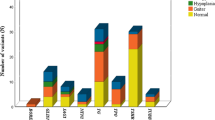Abstract
Background
Congenital hypothyroidism (CH) is the most common neonatal endocrine disorder in infancy. Dual oxidase 2 gene (DUOX2) mutations have been reported to be one of the leading genetic causes of CH.
Aim
The aim of this study was to screen for DUOX2 gene mutations among CH patients in the Guangxi Zhuang Autonomous Region of China and to define the relationships between DUOX2 genotypes and clinical phenotypes.
Materials and methods
Blood samples were collected from 45 CH patients in Guangxi Zhuang Autonomous Region, China, and genomic DNA was extracted from peripheral blood leukocytes. All exons of the DUOX2 gene together with their exon–intron boundaries were screened by Sanger sequencing.
Results
Sequencing analysis of DUOX2 in 45 CH patients revealed ten different variants in thirteen individuals. The variants included five known mutations, namely c.3329G>A (p.R1110Q), c.1588A>T (p.K530X), c.2635G>A (p.E879K), c.2524C>T (p.R842X) and c.4027G>T (p.L1343F), and one novel frame shift variant c.3340delC (p.L1114SfsX56), as well as four novel missense variants c.903G>T (p.W301C), c.2048G>T (p.R683L), c.1736T>C (p.L579P) and c.3413C>A (p.A1138D). The variant p.K530X is highly recurrent in our patient cohort but the clinical phenotypes vary greatly among those carrying this variant. Most patients with monoallelic or biallelic DUOX2 pathogenic variants turned out to be cases of transient congenital hypothyroidism (TCH), while three patients with triallelic DUOX2 pathogenic variants were associated with permanent congenital hypothyroidism (PCH).
Conclusions
The prevalence of DUOX2 pathogenic variants was high (29 %) among patients with CH in Guangxi, China. Monoallelic and biallelic DUOX2 pathogenic variants were mainly associated with TCH, while triallelic DUOX2 pathogenic variants were associated with PCH. Our study expanded the DUOX2 mutation spectrum, and functional studies of the novel mutations need to be conducted in the future.



Similar content being viewed by others
References
Szinnai G (2014) Clinical genetics of congenital hypothyroidism. Endocr Dev 26:60–78
Rastogi MV, LaFranchi SH (2010) Congenital hypothyroidism. Orphanet J Rare Dis 5:17
Hermanns P, Grasberger H, Cohen R, Freiberg C, Dorr HG, Refetoff S, Pohlenz J (2013) Two cases of thyroid dysgenesis caused by different novel PAX8 mutations in the DNA-binding region: in vitro studies reveal different pathogenic mechanisms. Thyroid 23:791–796
Rivolta CM, Targovnik HM (2006) Molecular advances in thyroglobulin disorders. Clin Chim Acta 374:8–24
Jain V, Agarwal R, Deorari AK, Paul VK (2008) Congenital hypothyroidism. Indian J Pediatr 75:363–367
Varela V, Rivolta CM, Esperante SA, Gruneiro-Papendieck L, Chiesa A, Targovnik HM (2006) Three mutations (p.Q36H, p.G418fsX482, and g.IVS19-2A>C) in the dual oxidase 2 gene responsible for congenital goiter and iodide organification defect. Clin Chem 52:182–191
Kumar P, Henikoff S, Ng PC (2009) Predicting the effects of coding non-synonymous variants on protein function using the SIFT algorithm. Nat Protoc 4:1073–1081
Schwarz JM, Rodelsperger C, Schuelke M, Seelow D (2010) MutationTaster evaluates disease-causing potential of sequence alterations. Nat Methods 7:575–576
Jin HY, Heo SH, Kim YM, Kim GH, Choi JH, Lee BH, Yoo HW (2014) High frequency of DUOX2 mutations in transient or permanent congenital hypothyroidism with eutopic thyroid glands. Horm Res Paediatr 82:252–260
Abe K, Narumi S, Suwanai AS, Hamajima T, Hasegawa T (2014) Pseudodominant inheritance in a family with nonautoimmune hypothyroidism due to biallelic DUOX2 mutations. Clin Endocrinol (Oxf) 83:394–398
Narumi S, Muroya K, Asakura Y, Aachi M, Hasegawa T (2011) Molecular basis of thyroid dyshormonogenesis: genetic screening in population-based Japanese patients. J Clin Endocrinol Metab 96:E1838–E1842
Moreno JC, Bikker H, Kempers MJ, van Trotsenburg AS, Baas F, de Vijlder JJ, Vulsma T, Ris-Stalpers C (2002) Inactivating mutations in the gene for thyroid oxidase 2 (THOX2) and congenital hypothyroidism. N Engl J Med 347:95–102
De Marco G, Agretti P, Montanelli L, Di Cosmo C, Bagattini B, De Servi M, Ferrarini E, Dimida A, Freitas Ferreira AC, Molinaro A, Ceccarelli C, Brozzi F, Pinchera A, Vitti P, Tonacchera M (2011) Identification and functional analysis of novel dual oxidase 2 (DUOX2) mutations in children with congenital or subclinical hypothyroidism. J Clin Endocrinol Metab 96:E1335–E1339
Vigone MC, Fugazzola L, Zamproni I, Passoni A, Di Candia S, Chiumello G, Persani L, Weber G (2005) Persistent mild hypothyroidism associated with novel sequence variants of the DUOX2 gene in two siblings. Hum Mutat 26:395
Grasberger H (2010) Defects of thyroidal hydrogen peroxide generation in congenital hypothyroidism. Mol Cell Endocrinol 322:99–106
Moreno JC, Visser TJ (2007) New phenotypes in thyroid dyshormonogenesis: hypothyroidism due to DUOX2 mutations. Endocr Dev 10:99–117
Weber G, Rabbiosi S, Zamproni I, Fugazzola L (2013) Genetic defects of hydrogen peroxide generation in the thyroid gland. J Endocrinol Invest 36:261–266
Vigone MC, Di Frenna M (2015) Weber G (2015) Heterogeneous phenotype in children affected by non-autoimmune hypothyroidism: an update. J Endocrinol Invest 38:835–840
Acknowledgments
We thank all members of the research group for their contributions to this investigation. We thank the National Natural Science Foundation of China (81260126), Key Projects of Guangxi Health Department (2012025) and Guangxi Natural Science Foundation Program (2012GXNSFAA053174) for financial support.
Author information
Authors and Affiliations
Corresponding author
Ethics declarations
Conflict of interest
The authors declare that they have no potential conflict of interest.
Ethical approval
This article does not contain any studies with human participants or animals performed by any of the authors.
Informed consent
For this type of study formal consent is not required.
Additional information
C. Fu and S. Zhang contributed equally to this work.
Rights and permissions
About this article
Cite this article
Fu, C., Zhang, S., Su, J. et al. Mutation screening of DUOX2 in Chinese patients with congenital hypothyroidism. J Endocrinol Invest 38, 1219–1224 (2015). https://doi.org/10.1007/s40618-015-0382-8
Received:
Accepted:
Published:
Issue Date:
DOI: https://doi.org/10.1007/s40618-015-0382-8




